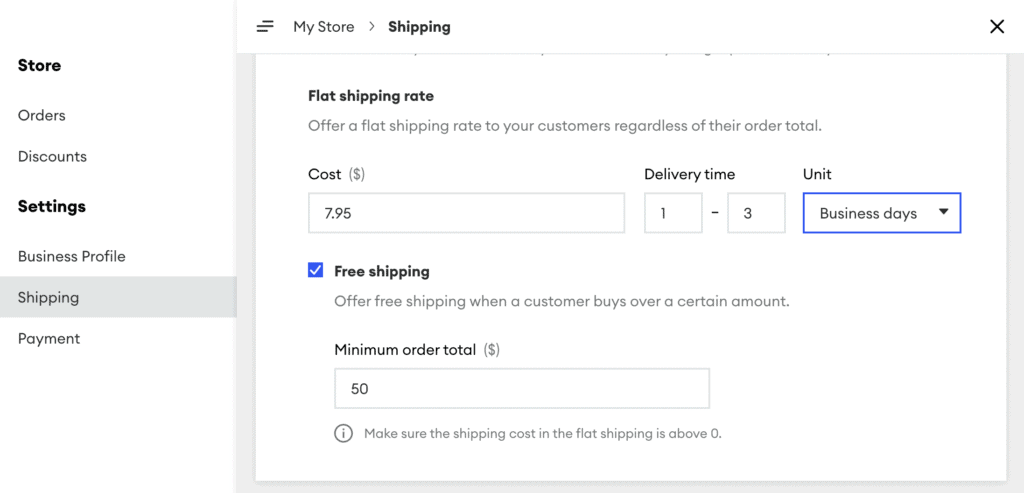As a shop owner you know that online customers are quite savvy. They hunt for the best deals, while you look to provide the best service and stay profitable.
One key to mastering this balance is understanding your shipping cost options and how they influence customer behavior. So we have put together some tips to find the right shipping options for you.
Transparency is key
Shipping “sticker shock” is one big reason why people might abandon their cart before making a purchase. That’s why it’s better all around to be transparent about shipping costs and simplify your cost calculations from the start. An FAQ section is a great way to address shipping costs clearly. You can also use this page to explain whether you ship internationally.
Keep it simple: flat rate shipping
Flat rate shipping applies regardless of the number of items in the shopping basket. What you charge the customer for shipping might not exactly match what you pay when you ship the item. But over time, the over- and under-payments typically even out, especially if you have a sense of what your average order costs to send.
Advantages for you: Billing, calculation, and labeling are simple. Shipping costs are calculated per order, not per item purchased. It’s also a good option if your store ships heavy items and offering free shipping isn’t realistic, or if most of your orders are a similar size
Benefits for your customers: This option offers complete transparency and is easy to understand. Customers know the total price at all times.
Another benefit: You can adjust the shipping costs for each market. So for example if you ship internationally, you’re not stuck with a one-size-fits-all shipping charge.

Note: For information on adjusting shipping costs using Jimdo Creator, check out our Help Center.
Free shipping for large orders
This is a good way to reward customers who spend more by offering them a bit of a break on the shipping costs. You can tell them that if they spend more than, let’s say, $50 on their order, they’ll automatically qualify for free shipping.
Advantages for you: If this option makes sense for your products, you can create a great incentive for your customers to order more. You can turn these options on by going to your menu and selecting Store > Overview > Shipping.
Benefits for your customers: The more your customers order, the less they pay proportionally for shipping.
Your customers will also see an alert on your products and checkout screen so they know what they need to spend in order to qualify for free shipping. It’s a great way to increase your average order value (AOV).
Note: If you’re using the Legal Text Generator, make sure to review your settings after turning free shipping on or off.
Charge shipping based on the size of the order
Sometimes one shipping rate doesn’t work for all orders. In that case, you can charge different amounts for shipping depending on how much the customer spends. With these kinds of tiered shipping rates, you can either 1) raise the cost of shipping on larger orders to help cover your own costs, or 2) lower the cost of shipping when people spend a certain amount of money, to incentivize them to spend more. For example, if you normally charge $10 for shipping, you might offer $5 shipping on orders over $100.
Advantages for you: Maximum flexibility. If you sell big, bulky items, shipping expenses can ramp up quickly. With adjustable rates, you can cover your costs by charging more for larger orders. Or, you can experiment with incentivizing people to spend more, without committing to free shipping.
Benefits for your customers: Shipping based on order size is a transparent way for customers to figure out how much they are paying. It can be more fair to customers who are placing small orders, or it can reward them for spending a bit more.
Skip the shipping all together—offer Local Pickup
Did you know that you don’t need to ship at all? If your customers tend to be nearby, try the Local Pickup option. That way, customers can schedule a window to come to your shop and pick up their order. No shipping necessary.
We also have some ideas if you’re looking for low-cost delivery options in your neighborhood. Bike messenger, self-delivery….it might be that the best option for you is to offer a different option altogether. With Jimdo, you can offer both local delivery and shipping.
Free shipping—is it worth it?
Customers love free shipping, as studies repeatedly confirm. This isn’t surprising, as free delivery feels like money saved. Customers don’t have to add an extra sum to the already perceived value in the next step of the order.
As a shop owner, it’s a good idea to take this little bit of sales psychology into account. By offering free shipping, your customers will feel like they have been treated fairly, without having to pay any “hidden costs.” But your next question is probably: “Can this really be profitable?”
There is no one correct answer, but it is often true that customers perceive free delivery, even at a slightly higher price, as a special service. So offering free delivery can often increase the chances of an order being placed.
Therefore free delivery can be worthwhile if you include the shipping into the product price, for certain actions or for a maximum shopping spend (for example orders over $50).
How can you tell if free shipping is working?
First, it helps to have a baseline. How many orders do you typically receive in a month? Then, try offering free shipping and see if your orders increase.
- If it doesn’t make a difference in sales, then it’s probably not worth carrying that cost.
- If it does make a difference in sales, the next part you might consider is how many of those customers who take advantage of free shipping become repeat customers.
A few other ideas to try out:
- Try adjusting the threshold for free shipping to see what works best. Think about the average amount a customer spends in your store, and try making the minimum for free shipping slightly above that.
Example: If customers typically buy one shirt from your store for $20, try setting your free shipping threshold at $30. That might nudge the customer to buy a second shirt they had their eye on, or add a smaller item to make up the $10 difference.
- If you’re concerned about changing your shipping policies, you can try turning on reduced or free shipping for a month as a “special” for customers to see how they react. For example, you can set up “Free shipping all December long!” as a discount campaign, and then turn it off again with the click of a button.
In the mind of customers, delivery is just as much a part of the shopping experience as professional product images or clear product descriptions. By having well thought-out shipping options you can really add value to a customer’s experience with your shop. So it can actually pay off to reconsider the shipping costs for your store.

